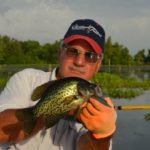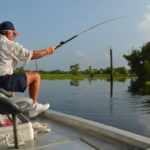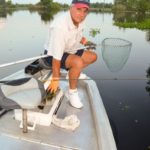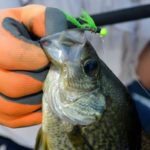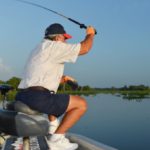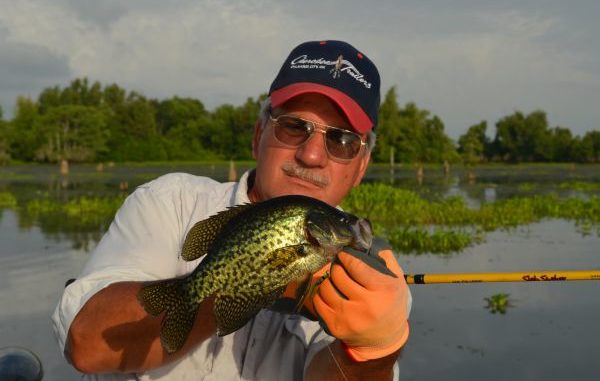
Many complain that crappie are finicky, making catching them a hit-or-miss proposition. But this expert has it all figured out.
Zounds! This guy is good.
He made catching sac-a-lait from Lake Henderson look like taking candy from a baby. It was like watching a hybrid between a robot and a ballet dancer at work. No moves were wasted; everything seemed programmed.
Yet it was all graceful.
The sac-a-lait, aka white perch or crappie, is a dearly beloved fish in Louisiana. In fact, it is the official state fish. They taste great, and they are common. Everybody can catch a few of them.
A few people consistently catch a lot of them.
Murphy “Murph” Royer is one of those few.
The dapper 63-year-old retired drug store manager fishes four to five days a week, year-round.
“When I was a kid I was always in ditches — fascinated by fish,” Royer grinned. “When I was 6 or 7, we lived near a pond. My mother had to come get me out of it all the time.
“I really got hooked when I was about 21. I had a brother-in-law who fished sac-a-lait. I got hooked when I ate them. Plus, they are a challenge to master. If you don’t know what you are doing, you’re not going to catch them. It took me 10 years to master them.”
And now he goes wherever he hears the crappie are active.
“I’ll go wherever they are biting,” Royer said. “It doesn’t matter to me: Saline Bayou and lake, French Fork, Old River in LaSalle Parish, Black Lake-Clear Lake, Lake Verret, the (Atchafalaya) Basin — both inside and outside the levees, the Mermentau River, Chicot Lake and Millers Lake.
“But my favorite place is Henderson. It’s so close. When they are on in Henderson, they are on.”
Creeping daylight found Royer launching his custom-built, welded aluminum boat at the public boat landing located between the Interstate Highway 10 spans at Butte Larose.
Five minutes later, he was fishing.
First stop was a line of willow trees fringed with water hyacinths just north of the highway. The tree line marked the submerged banks of a canal.
In the middle of the “canal” (there was water everywhere), Royer slipped out of the driver’s seat and onto the front pedestal seat of the boat, and eased the trolling motor into position.
As soon as he came near enough to the lilies along the tree line to reach them, he whipped the jig into the water.
Unlike many jig fishermen, who slowly and deliberately swing their lures for perfect placement, Royer flailed the water — looking for all the world like Lash LaRue using his bull whip.
(Trivia: The original western movie star Alfred “Lash” LaRue, who died in 1996, hailed from Gretna.)
Three, four, five twitches of the jig suspended under a cork, and he snatched the bait out of the water and presented it to another spot and hopefully a receptive fish.
He began putting fish in the boat immediately.
Only then did the efficiency of the boat’s layout become obvious.
A well just large enough for a 48-quart ice chest was centered on the boat’s expansive bow deck. Immediately on either side of the well were two pedestal seats, allowing two anglers to fish from the bow and both to box their catch without getting up from their seats.
A towel to dry the anglers’ hands lay beside the ice chest, and a lap counter clicker to keep track of the number of fish caught was on the deck beside Royer’s feet.
Seven rigged jig poles were laid out side by side. Between the jig poles, seated in a bracket within easy hand-reach, was Royer’s landing net mounted on a 10-foot aluminum pipe.
He could do virtually anything related to fishing without leaving his seat.
As he did all morning, at least until 9:30 when he had an ice chest full of fish and returned to the launch, he sometimes picked up two or three sac-a-lait in one spot and other times picked up single fish.
“With this kind of fishing,” he coached, “you have to move a lot. If you catch several from a spot and they quit, leave it and come back later; sometimes you will catch more.”
Occasionally, when the fish stopped biting after he caught several from a spot, he would exchange jig poles and try a different-colored jig. Often it produced another fish or two.
He used his long-handled landing net for larger fish and those that were poorly hooked. Others he would lift and swing in to his free hand.
He was choosy, too, tossing back anything under 10 inches long.
Some of what he returned looked awfully big to me, so I rashly challenged him about the size. He grinned and patiently measured a fish: It was 9 7/8 inches long. His grin became even broader.
The sun still wasn’t on the water yet, and he was racking up fish after fish. Some were white crappie, but most were black. It was easy to tell the difference. The black specks on the flanks of the white crappie were loosely arranged in five or six vertical bars, and they had longer “ski-jump-shaped” noses. The specks on the sides of black crappies were more uniformly scattered, and their snouts were shorter.
The crappie expert strongly preferred the black species.
“(Black crappie) fight harder,” Royer said. “Whites fight a little, and then give up. Blacks take off like a bat.
“Black crappies also have firmer flesh.”
The fishing was hot and heavy until 6:10 a.m. when the sun hit the water directly. Then the fishing slowed down to merely very good.
He had to pick and poke a bit to find them, which he steadily did.
With better light, the color and clarity of the water was easier to discern. He liked what he saw.
“When I drop my jig into the water, if I can see it more than 10 inches down, it’s too clear,” Royer said. “If the jig disappears at 4 to 5 inches, it’s perfect.”
He said visibility can be even less than that and still yield crappie.
“You can catch fish in muddy water — they can see it,” Royer said. “I recently fished in the Mermentau River; the water was so muddy that my jig disappeared when it hit the water. I caught good.”
Success often is just a matter of adjusting to the conditions.
“In muddy water, use dark jigs,” he said.
He continued his water-quality lesson by talking about oxygen. Jet black water is bad, he explained and so is the presence of a lot of bubbles on the surface. Both mean low or no oxygen.
He likes to see fish activity, and pays close attention to the presence of minnows. No minnows means no oxygen.
“Sometimes I only catch sac-a-lait where I see a certain kind of big minnow,” Royer said. “The fish can be anywhere in the lake, and I will move looking for baitfish.”
The bite maintained its steady pace. The fish seemed aggressive and often swallowed the jig.
He dislodged deep-hooked jigs with a deft jab of his gloved forefinger down the fish’s throat. The gloves, he explained, allow for fast grabbing because of their non-slip grip, and they also protect against fish spines.
Mixed with the sac-a-lait were a few bluegills and chinquapins (aka lake runners). If they were big enough to suit him, they joined the sac-a-lait in the ice chest.
The bream invariably snatched the cork under. Some sac-a-lait took it the same way, but most bites were more subtle. Sometimes the cork slowly eased underwater. Sometimes, when the fish picked up the jig and held it without moving, the cork flipped up on its side. Other times it just twitched.
Royer used a cork — the smallest that would suspend the jig — the entire morning, but he explained that his preference is for fishing tight-line.
“What I like about fishing tight-line is that you can really feel them hit it,” he said with an sassy grin.
He added that his fishing technique is different when he tight-lines.
“I only have about 6 feet of line out, and I fish straight down, giving gentle jigs,” Royer said. “But sometimes corks are better. It seems like when the fish want a lot of movement corks work better. Also, corks work well early in the morning.
“When the sun gets higher, the fish go deeper. I either fish tight-line then or set my cork deeper.”
The big lake, more green with vegetation than blue, was peaceful in spite of the low hum of vehicles passing on the elevated interstate within eyesight to the south. The morning couldn’t have been more perfect, but like all good things, it had to end.
Back at the landing, I asked him if he ever gets tired of fishing. He looked at me as if I had just asked the stupidest question in the world before he replied.
“Nope! No,” Royer said. “I love it! I like to feel the thump. I like to see the cork pop. I like to see it going under. I like to see them flouncing.
“Plus, I like to clean them and give them away. People love to eat them. They are the filet mignon of the fish world.”
